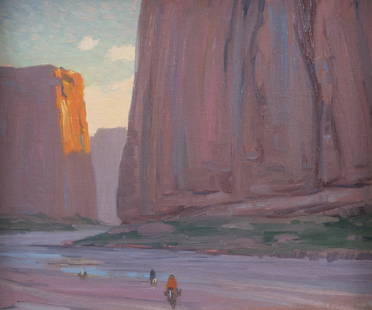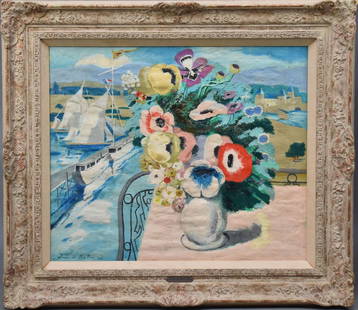
VALENTIN DE ZUBIAURRE AGUIRREZÃBAL (Madrid, 1879-1963). "Segoviana con bola dorada", ca.1915-1920.
Similar Sale History
View More Items in PaintingsRelated Paintings
More Items in Paintings
View MoreRecommended Art
View More






Item Details
Description
VALENTIN DE ZUBIAURRE AGUIRREZÃBAL (Madrid, 1879-1963).
"Segoviana con bola dorada", ca.1915-1920.
Oil on canvas.
Signed in the lower right corner.
Bibliography: Revista Plus Ultra, nº 55, year V. Buenos Aires, 1920.
Size: 60,5 x 47 cm; 86 x 73 cm (frame).
The retrospective and nostalgic look, full of tenderness, towards the regional roots that ValentÃn de Zubiaurre expresses in his paintings is on this occasion enhanced by the baroque resource of the crystal ball. It should be remembered that the reflecting sphere was used in the 17th century to enhance the complexity of perspective and the play of gazes, but also to allude to the passage of time. Pieter Claesz used it in both senses in his still lifes. The ball held by the old woman portrayed by Zubiaurre contains on its convex surface the self-portrait of the painter in his studio, the same resource used by Claesz in "Still Life with a Glass Sphere" (a canvas now in the Germanisches Nationalmuseum in Nuremberg), an image that the glass transforms into a spectral one, into pure memory, into indelible remembrance. This lends great expressive power to the painting as a whole. This work falls within the framework of the rise of regionalism in Spain in the second half of the 19th century and the first third of the 20th century, an art with a Romantic, costumbrista heritage and a realistic, meticulous style, which focused on depicting subjects, themes and characters reflecting a new sense of folklore. In this context, the painters sought to reflect the types and customs of their own land, which made it different and unique, thus vindicating the traditions and ways of dressing and behaving that were threatened by the notable growth of urban areas and the imposition of fashions brought in from outside.
The son of the musical composer of the same name, ValentÃn Zubiaurre was born deaf and dumb, like his younger brother Ramón, also a painter. He began his training with the painter Daniel Perea before entering the San Fernando Royal Academy of Fine Arts in 1894. There he was a disciple of Carlos de Haes, Muñoz Degrain, Ferrant and Moreno Carbonero. In 1898 the two Zubiaurre brothers set out on a study trip that took them to France, Italy and the Netherlands. On their return to Spain they obtained a grant from the Diputación de Vizcaya in 1902, which enabled them to settle in Paris. They attended classes at the Académie Julian and became acquainted with modern trends, but were not permeable to their influence, mainly due to the weight of their academic training and their admiration for both the Flemish and Italian primitives and contemporary Spanish painters such as DarÃo de Regoyos and Ignacio Zuloaga. ValentÃn de Zubiaurre regularly sent his works to the National Fine Arts Exhibitions and was awarded several prizes; in 1908 he won the second medal and in 1917 the first. He was also distinguished with prizes from foreign institutions and won prizes at important international competitions held in the first decade of the 20th century, including those of Munich, Buenos Aires, Brussels, San Francisco and San Diego. From the 1920s onwards, the Zubiaurre brothers experienced their most successful period, both in Spain and internationally. After the war ValentÃn de Zubiaurre resumed his career in Spain, and his recognition became official with his appointment as a full member of the San Fernando Royal Academy of Fine Arts in 1945, culminating in the medal of honour awarded to him at the National Exhibition of Fine Arts in 1957, six years before his death. He is currently represented in the Fine Arts Museums of Chicago, Buenos Aires, Paris, Luxembourg, Munich, Berlin, Tokyo, Pittsburg and San Diego, as well as in the main art galleries of the Basque Country, the Castagnino Museum in Argentina, the Reina SofÃa National Art Centre, the BBVA collection and the Museum of Modern Art in Rome, among others, both public and private.
"Segoviana con bola dorada", ca.1915-1920.
Oil on canvas.
Signed in the lower right corner.
Bibliography: Revista Plus Ultra, nº 55, year V. Buenos Aires, 1920.
Size: 60,5 x 47 cm; 86 x 73 cm (frame).
The retrospective and nostalgic look, full of tenderness, towards the regional roots that ValentÃn de Zubiaurre expresses in his paintings is on this occasion enhanced by the baroque resource of the crystal ball. It should be remembered that the reflecting sphere was used in the 17th century to enhance the complexity of perspective and the play of gazes, but also to allude to the passage of time. Pieter Claesz used it in both senses in his still lifes. The ball held by the old woman portrayed by Zubiaurre contains on its convex surface the self-portrait of the painter in his studio, the same resource used by Claesz in "Still Life with a Glass Sphere" (a canvas now in the Germanisches Nationalmuseum in Nuremberg), an image that the glass transforms into a spectral one, into pure memory, into indelible remembrance. This lends great expressive power to the painting as a whole. This work falls within the framework of the rise of regionalism in Spain in the second half of the 19th century and the first third of the 20th century, an art with a Romantic, costumbrista heritage and a realistic, meticulous style, which focused on depicting subjects, themes and characters reflecting a new sense of folklore. In this context, the painters sought to reflect the types and customs of their own land, which made it different and unique, thus vindicating the traditions and ways of dressing and behaving that were threatened by the notable growth of urban areas and the imposition of fashions brought in from outside.
The son of the musical composer of the same name, ValentÃn Zubiaurre was born deaf and dumb, like his younger brother Ramón, also a painter. He began his training with the painter Daniel Perea before entering the San Fernando Royal Academy of Fine Arts in 1894. There he was a disciple of Carlos de Haes, Muñoz Degrain, Ferrant and Moreno Carbonero. In 1898 the two Zubiaurre brothers set out on a study trip that took them to France, Italy and the Netherlands. On their return to Spain they obtained a grant from the Diputación de Vizcaya in 1902, which enabled them to settle in Paris. They attended classes at the Académie Julian and became acquainted with modern trends, but were not permeable to their influence, mainly due to the weight of their academic training and their admiration for both the Flemish and Italian primitives and contemporary Spanish painters such as DarÃo de Regoyos and Ignacio Zuloaga. ValentÃn de Zubiaurre regularly sent his works to the National Fine Arts Exhibitions and was awarded several prizes; in 1908 he won the second medal and in 1917 the first. He was also distinguished with prizes from foreign institutions and won prizes at important international competitions held in the first decade of the 20th century, including those of Munich, Buenos Aires, Brussels, San Francisco and San Diego. From the 1920s onwards, the Zubiaurre brothers experienced their most successful period, both in Spain and internationally. After the war ValentÃn de Zubiaurre resumed his career in Spain, and his recognition became official with his appointment as a full member of the San Fernando Royal Academy of Fine Arts in 1945, culminating in the medal of honour awarded to him at the National Exhibition of Fine Arts in 1957, six years before his death. He is currently represented in the Fine Arts Museums of Chicago, Buenos Aires, Paris, Luxembourg, Munich, Berlin, Tokyo, Pittsburg and San Diego, as well as in the main art galleries of the Basque Country, the Castagnino Museum in Argentina, the Reina SofÃa National Art Centre, the BBVA collection and the Museum of Modern Art in Rome, among others, both public and private.
Buyer's Premium
- 23%
VALENTIN DE ZUBIAURRE AGUIRREZÃBAL (Madrid, 1879-1963). "Segoviana con bola dorada", ca.1915-1920.
Estimate €10,000 - €12,000
Shipping & Pickup Options
Item located in Barcelona, -, esOffers In-House Shipping
Payment

Related Searches
TOP















































![Andre Cottavoz "Coutre-Jour de Soir" Oil on Canvas: Andre Cottavoz (French, 1922-2012), "Coutre-Jour de Soir, Aout" [Evening Daylight, August], Oil on Canvas, 1958, signed and dated lower right, titled, signed, and dated "8-58" to verso with Taylor Gra](https://p1.liveauctioneers.com/5649/323838/174273490_1_x.jpg?height=310&quality=70&version=1711142965)





















